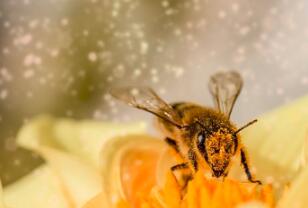
Source of pictures: Pixabay.com
Daniel came home from school, and he smelled something great. He followed the smell to the kitchen, where his mom, wearing thick gloves, was taking the cake out of the oven. Daniel asks, "Mom, what kind of cake did you make today. It smells good!"
Mom looked at her greedy cat and said with a smile, "It is the honey cake. I made it with the honey your grandma brought from home."
Daniel picked up a small cake, which looked like a golden shell, blew it and took a bite. The soft cake melted slowly, and a sweet taste rose up, as if you could see the blooming flowers in spring and hear the buzzing of bees. Daniel licked his lips contentedly and said, "Mom, it is so delicious!"
Mom said happily, "Honey seems to be a good thing. It is different from sugar. Grandma said it was the honey of various flowers. She bought it from a beekeeper. It was really hard to find."
Daniel took another bite and said, "Why don't bees eat honey themselves? It is so good."
Mom arranged the cakes one by one and said, "Of course they do. Honey is bees' food, and people produce honey by bee-keeping."
"How do bees make honey?" Even cakes couldn't stop Daniel's curiosity.
"Bees work hard at collecting pollen to make honey. Bees are gregarious animals. A hive is a group. There are usually around 60,000 bees in a hive, including three kinds of bees, the queen, drones and worker bees that are responsible for collecting pollen. The worker bees are at their busiest in spring when the flowers are in full bloom. They fly from one cluster to another, collecting pollen with their specific tube-shaped mouths into their honey sacs which won't digest pollen (this process is called honey collection). It’s just a temporary storehouse for pollen." Mom picked up a cake as well.
"And then? Are they going to spit it out when they come back home?" Daniel couldn't help asking.
"That’s what they do. When the worker bees come back, the bees in the hive will suck it out and chew it. As they chew, they secrete enzymes including invertase, protease, amylase, glucose oxidase, and lysozyme, which, when mixed with the pollen, turn it into glucose and fructose, a thick syrup (this process is called ripening nectar). Then they spit the syrup all over the hive and let the water evaporate. This is basically how honey is made. Worker bees gather flower pollen, chew it, mix it with enzymes, and spit it all over the hive to form the syrup. As the syrup gets thicker and drier, it becomes food. The bees also put a layer of beeswax on it so that it will last longer," added Mom.
"Is it all right if we take their honey? Do the bees have anything to eat?"
"Usually, people are not so greedy. The beekeeper doesn’t take all the honey from the beehive. They will leave some for the bees in winter. They are like partners. The beekeeper provides or finds flowers for the bees, and the bees provide the honey. Even if people don’t take the honey, bees will be prepared for that, because some birds or insects may eat their honey, too. They will make as much honey as they can and store enough food for the winter. That is why bees are always so busy. Once they miss the flowering period, they will lose the pollen and go hungry in winter."
"Bees don't just make honey. They also act as matchmakers for fruit trees and vegetables. They will pollinate between flowering plants. Some plants do not produce fruit until they are pollinated, and a third of our food needs to be pollinated."
Daniel looked down at the cake on the table. He had not thought about that making honey was so complicated. No wonder it was so delicious.
Author: Huang Jing

















 京公网安备11010502039775号
京公网安备11010502039775号





